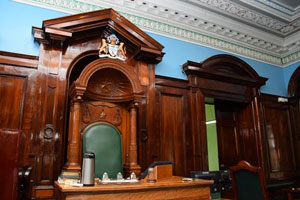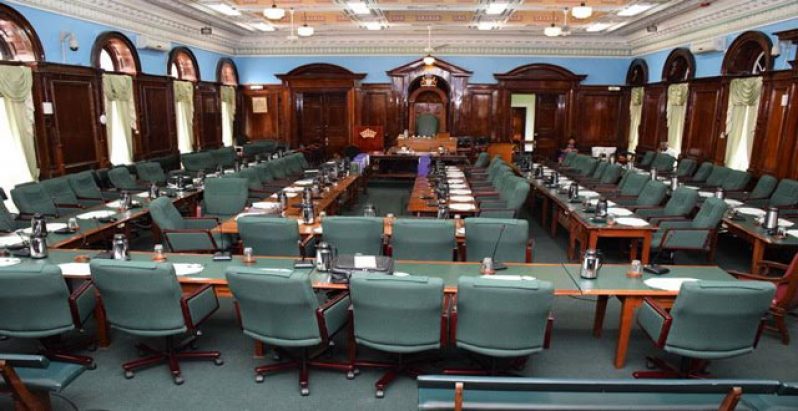TODAY, June 10, 2015, is a significant date for Guyana. It marks the opening of Guyana’s Eleventh Parliament. Every opening of a nation’s parliament is historical, since it is primarily precipitated by national elections, which either occasions the return to office of the incumbent, or if defeated, being succeeded by a new government.
TRULY HISTORICAL
For Guyana, this particular occurrence is indeed historical for the uniqueness of the occasion, apart from the fact that it will be conducting business as a result of a change in government, with the latter constituting the first coalition of political parties that contested a national election, and emerged winners. The six-party coalition was declared the winner of the May 11 general and regional elections, which is itself another historic feat, and got 33 of the 65 seats in the National Assembly.

TODAY’S OPENING
Today’s session of Parliament, when called, will begin with a proclamation summoning the session, and a roll call by the Clerk of the National Assembly. This will be followed by the election of the Speaker of the National Assembly, and the Deputy Speaker. Members of Parliament will then be administered their Oath of Office, after which the order of business will be read by the newly-appointed House Speaker.
There will be a short recess around 15:00 hrs. (3 pm) to cater for the arrival of President David Granger, who will address the National Assembly, after inspecting a ceremonial Guard of Honour on the forecourt of the Public Buildings. The President’s address is expected to set the tone of the National Assembly.
The first sitting of the National Assembly is strictly invitational; however, the proceedings will be streamed live, via the Internet, and shown on two large screens on the eastern and western sides of the Public Buildings. Tents and chairs will also be set up on the forecourt where persons can follow the proceedings as they occur in real time in Chambers.
PUBLIC BUILDINGS
Guyana’s Parliament is housed in what can be described as an imposing structure, designed by the architect, Joseph Hadfield, and built at a cost of 50,000 pounds sterling. Completed in 1834, this august Assembly is housed in a well-maintained structure known as the Public Buildings, and occupies an entire bloc, bounded on the south by Hadfield Street; on the north by Brickdam; on the east by the Avenue of the Republic; and on the west by Water Street.
The buildings, done with slave labour, were used to house several government offices of the colony’s administration. The need for other buildings resulted in a Court Hall and Registrar’s Office being constructed. Upon completion, the offices of the Public Buildings were arranged as such: The Court of Policy Hall with offices for the Governor’s secretary, assistant, and clerks. The Supreme Court of Criminal and Civil Justice were in the western upper wing, with the lower floor divided into offices for the Registrar and staff. The central portion of the buildings consisted of apartments for barristers, the Administrator-General, Financial Representatives and the Governor of the Colony. The lower floors housed offices of the Administrator-General, Auditor-General, Provost Marshal, Deputy Provost Marshall, Deputy Post Master General, Financial Accountant, Receiver General and other functionaries.
The flowered, cast-iron picket fence was constructed in 1873, and previously, the entire compound was open. The forecourt of the building was used at the time for the execution of criminals. Slave rebellion leader, Damon, was executed in the yard for his role in the Essequibo Uprising in 1834. His revolt was against the apprenticeship system introduced by the planters after the freeing of slaves in that same year.
In 1875, Maltese-born Cesar Castellani completed the installation of a sunken panelled ceiling of the Parliamentary Chamber in the eastern wing. The carved teak chair of the Speaker, an Independence gift from the Government of India, is sited in these chambers. A table and three chairs for the Clerks and the Sergeant-at-Arms were given as Independence gifts from the United Kingdom’s House of Commons. A gilded clock from the Demerara Company Limited hangs in the Chambers, the walls of which are panelled with mahogany.
The Public Buildings are described as an excellent example of 19th Century Renaissance architecture, and is one of two domed buildings still remaining in Georgetown. The forecourt of the edifice has two canons, relics from the Crimean War, and a statue of Hubert Nathaniel Critchlow, OBE (1884-1958), regarded as the Father of the Trade Union Movement in Guyana.
ITS EVOLUTION
The current Parliament traces its colourful history back to the time of the Dutch, with the earliest parliamentary bodies established by this coloniser, known as the Council of Policy, the Court of Policy, the Court of Justice, and the College of Keizers. With the arrival of the British, modifications began, constitutions were introduced, that eventually bring us to what is definitely a modern parliamentary system, modelled after the Westminster system.
The current Parliament came into existence by the 1966 Constitution of Guyana, as embodied in the Schedule of the Guyana Independence Order, of the Independence Act, 1966.

THE FIRST PARLIAMENT
The first sitting of the National Assembly of the First Parliament was held on May 26, 1966.
Before Guyana achieved its independence, the policy speech that outlined government’s policies and plans, was read in the Chamber of what was then described as the legislative Assembly, by the Governor, who was the representative of the British monarch.
This practice came to an end when Guyana changed its status to that of a Republic, with the Head of State, of ceremonial type, performing the task of announcing government’s policies.
However, in 1980, the national Constitution was amended. This created an Executive President as both Head of State/Government, who, on the opening of every new Parliament, goes to the National Assembly, and addresses its members. In accordance with this Constitution, the Sitting of the National Assembly is only referred to as Parliament when the President visits. On all other occasions, it is referred to as the National Assembly.
It is against this background that today’s special opening of Parliament will be held, amidst the heightened preparations that have seen a complete beautification of the forecourt of the Public Buildings, where the President will inspect a Guard-of-Honour before he is escorted to the august Chamber.
PROROGATION
The 9th Parliament ended in September 2011 and the 10th was convened in February 2012. This was prorogued by then President Donald Ramotar and dissolved on February 28, 2015, thus paving the way for the May 11 General and Regional elections.
PARLIAMENT’S FUNCTIONS
The functions of the National Assembly revolve around the Speaker, the Mace and the Sergeant-at-Arms.
Beginning with the Speaker, in the Guyana context that person is often elected by the sitting government, from among its Members of Parliament, while the Deputy Speaker is traditionally chosen from the Opposition side of the House.
THE SPEAKER
The fact that the Speaker sits in an elevated, middle position, with both sides of the House flanking his chair, underlines his authority.
His entry into the Chamber is preceded by the Sergeant-at-arms, who carries the Mace, the symbol of the Speaker’s authority. The entire chamber rises on his entry, and takes their seats after him/her. The Sergeant-at-Arms then places the Mace on the table in front of the Speaker. This means that the House is in session. Whenever he leaves the Chamber, the Sergeant-at -Arms removes the Mace. This signals that the House is no longer in session.
The Speaker ensures the orderly conduct of matters within the House. He can be described as a referee, interpreting rules in an impartial manner; and defending the rights and privileges of members, including the right of speech. He does not participate in debates, and can suspend a sitting in the case of serious disorder.
THE MACE
The Mace is the symbol of the Speaker’s authority. It is borne on the shoulder by the Sergeant-at-Arms, who walks in front of the Speaker as the latter enters the Chamber.
When the Mace is placed on the Speaker’s table, the House is in session; out of the House, matters cannot be addressed.
SERGEANT-AT-ARMS
Apart from bearing the Mace, the Sergeant-at-Arms’ main function is being responsible for security matters. He can escort a Member of Parliament out of the House by order of the Speaker.
THE CHAMBER SETTING
The Guyana Parliament comprises 65 seats elected through the system of proportional representation. Twenty-five (25) of the Members are elected from the 10 geographical constituencies and therefore represent the people from these regions. The 40 other seats come from the national top-up list. (GINA)




.jpg)










